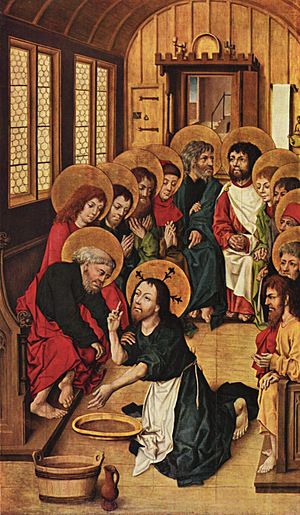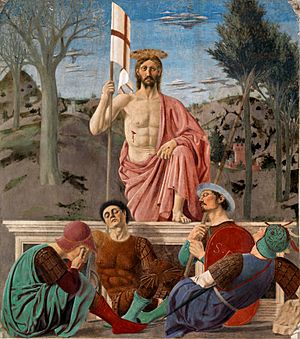Paschal Triduum facts for kids
The Paschal Triduum or Easter Triduum is a special three-day period for Christians. It starts on the evening of Maundy Thursday, reaches its most important point with the Easter Vigil, and ends on Easter Sunday evening. These three days remember the most important events in the Christian faith: Jesus' suffering, His death, burial, and rising from the dead.
Different Christian groups, like Anglicans, Lutherans, and Methodists, see the Triduum as a bridge between Lent (a time of preparation) and Eastertide (the Easter season). In the Roman Catholic Church, it's considered a separate, very important time of the year.
Historically, some of these celebrations happened earlier in the day. But after changes in 1955, they were moved to the evening. During this time, from Thursday evening until Easter Sunday, church bells are often silent, and organs are not played. This quiet time was once called "the still days." Weddings are also usually not held during the Triduum.
Maundy Thursday (also called Holy Thursday)

Maundy Thursday remembers the Last Supper, when Jesus shared a final meal with His disciples.
In many churches, especially Catholic and Anglican ones, the Mass of the Lord's Supper begins with the ringing of all church bells and organ music during the "Gloria in Excelsis Deo" hymn. After this, the bells and organ become silent until the Easter Vigil.
A special part of this service is the washing of the feet, where a priest or pastor washes the feet of some people, just as Jesus washed the feet of His disciples. The service ends with a procession of the Blessed Sacrament (the consecrated bread) to a special altar of repose. People are encouraged to stay and pray quietly before it. After the service, altars in the church are often stripped bare, meaning all cloths and decorations are removed.
The special color for church clothes and decorations on Maundy Thursday is usually white, symbolizing joy and purity.
Good Friday
On Good Friday, Christians remember Jesus' suffering and His death on the cross. It is a day of sadness and reflection.
In many churches, a cross or crucifix is uncovered in a special ceremony. In Catholic churches, priests often begin the service by lying flat on the floor in front of the altar. No regular Mass is celebrated on Good Friday. Instead, a special service called the "Celebration of the Lord's Passion" is held, where communion is given using bread that was consecrated on Maundy Thursday.
It is also common for statues of saints and crucifixes in Catholic churches to be covered with purple cloths during the last two weeks of Lent, and they remain covered until after the Good Friday service. Many people show their respect by kissing or touching the feet of the crucifix.
The colors for church clothes on Good Friday can vary. Red is often used in the Catholic Church, symbolizing Jesus' blood. Some traditions use black, representing mourning, or no color at all.
Holy Saturday

Holy Saturday is a quiet day that remembers Jesus' time in the tomb after His death. It leads up to the most important service of the year: the Easter Vigil. This vigil service is held after sunset on Holy Saturday or before dawn on Easter Sunday.
The Easter Vigil begins with a special ceremony of darkness and light. A new fire is lit outside the church, and from this fire, the large paschal candle is lit. This candle symbolizes Jesus rising from the dead. A solemn procession then carries the lit Paschal candle into the dark church.
After the candle is in place, a special song called the "Exsultet" is sung, celebrating Christ's resurrection. Then, everyone sits and listens to several readings from the Old Testament. These readings tell the story of God's plan for salvation, starting from creation.
During the "Gloria" hymn at the Easter Vigil Mass, the organ and church bells are used again for the first time in two days. If the church lights were off, they are turned on as the Gloria begins. The Paschal candle is also used to bless the water in the baptismal font. The "Alleluia" is sung again, which hasn't been heard since before Lent. This is a joyful time, and often, people who have been preparing to join the Church are baptized and confirmed during this service.
The color for church clothes and decorations on Holy Saturday and Easter Sunday is usually white, often with gold, symbolizing joy and new life.
Easter Time
Easter is a "moveable observance", meaning its date changes each year. It happens on the first Sunday after the first full moon that occurs on or after March 21. The earliest Easter can be is March 22, and the latest is April 25.
The Easter season is a joyful time that lasts for 50 days, from the Easter Vigil until Pentecost Sunday. During this period, churches continue to celebrate Jesus' resurrection.
The special color for church clothes and decorations during the Easter season is generally white or gold, showing joy and celebration.
See also
 In Spanish: Triduo Pascual para niños
In Spanish: Triduo Pascual para niños
- Holy Week
- Holy Week procession


